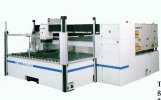EFRESH_PROPERTIES_laser

All about freshlook
|

Send a mail
|
THE LASER TECHNOLOGY

Click here to see pictures of our lasers.
Laser is an acronym for Light Amplification by Stimulated Emission of Radiation.
Lasers are devices that amplify light and produce coherent light beams, ranging
from infrared to ultraviolet. A light beam is coherent when its waves, or photons,
propagate in step with one another. Laser light can be made extremely intense,
highly directional, and very pure in frequency and thus colour. Laser devices now
extend into the X-ray frequency range.
Lasers harness atoms to store and emit light in a coherent fashion. The electrons
in the atoms of a laser medium are first pumped to an excited state by an energy
source and are then stimulated by external photons to emit the stored energy in
the form of photons, a process known as stimulated emission. The photons emitted
have a frequency characteristic of the atoms and travel in step with the
stimulating photons. These photons in turn impinge on other excited atoms to
release more photons. Light amplification is achieved as the photons move back
and forth between two parallel mirrors, triggering further stimulated emissions.
The intense, directional, and monochromatic laser light finally leaves through
one of the mirrors, which is only partially silvered.
Stimulated emission, the underlying process for laser action, was first proposed
by Albert Einstein in 1917. However, it was not until 1954 that American
physicist Charles Townes created a population inversion in a device that
amplified microwaves, a maser. The first laser was constructed in 1960 by
Theodore Maiman in the United States.
Lasers have become valuable tools in industry, scientific research, communication,
medicine, the military, and the arts.
Powerful laser beams can be focused on a small spot with enormous power density.
Consequently, the focused beams can readily heat, melt, or vaporise material in a
precise manner. Lasers have been used, for example, to drill holes in diamonds, to
shape machine tools, to trim microelectronics, to heat-treat semiconductor chips, to cut
steel patterns, to synthesise new material, and to attempt to induce controlled nuclear
fusion. The powerful short laser pulse also makes possible high-speed photography with
an exposure time of several trillionths of a second.
Lasers are used for monitoring movements of the earth�s crust and for geodetic surveys.
They are also the most effective detectors of certain types of air pollution. In addition,
lasers have been used for precise determination of the earth-moon distance and in tests
of relativity. Very fast laser-activated switches are being developed for use in particle
accelerators, and techniques have been found for using laser beams to slow down atoms for
extremely precise studies of their spectra.
Laser light is highly directional and monochromatic, consequently extremely small amounts
of light scattering or small frequency shifts caused by matter can easily be detected. By
measuring such changes, scientists have successfully studied molecular structures of
matter. With lasers, the speed of light has been determined to an unprecedented accuracy,
chemical reactions can be selectively induced, and the existence of trace substances in
samples can be detected.
Laser light can travel a large distance in outer space with little reduction in signal
strength. Because of its high frequency, laser light can carry, for example, 1000 times
the television channels today carried by microwaves. Lasers are therefore ideal for space
communications. Low-loss optical fibres have been developed to transmit laser light for
earthbound communication in telephone and computer systems.
Intense, narrow beams of laser light can cut and cauterise certain tissues in a small
fraction of a second without damaging the surrounding healthy tissues. They have been
used to 'weld' the retina, bore holes in the skull, vaporise lesions, and cauterise
blood vessels. Laser techniques have also been developed for lab tests of small
biological samples.
Laser guidance systems for missiles, aircraft, and satellites are being studied and
constructed. The use of laser beams has been proposed against hostile ballistic missiles.
FRESHLOOK LASERS
Freshlook's first laser cutting machine had a Rofin-Sinar 500 Watt Resonator on a flying
optic bed. Managing Director Barnaby Higson had been using the machine to develop a
revolutionary wheelchair design, the laser being the perfect development tool. When, in
1989, the wheelchair development was effectively complete the company went public and
relocated in the North. Higson acquired the laser and formed Freshlook, working in the
early years predominantly as a supplier to Chairpower but soon building a reputation as
a job shop supplier of quality laser-cut components.
Other lasers followed over the years and the current flagship machine is the exceptional
LVD Shape HELIUS. Taking advantage of all the technological developments of recent years,
particularly in processor speeds, LVD have 'created' a flexible, high speed, high
accuracy compact machine that really sets the standard by which other laser-cutting
machines are measured.
This is a small selection of a wide range of materials that we can cut with our lasers :



